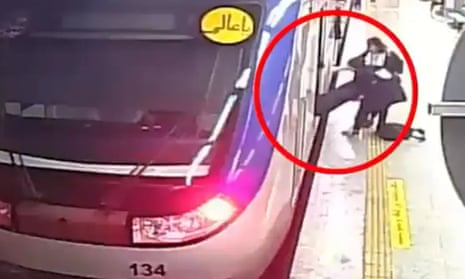The hospitalisation of a 16-year-old girl in Tehran has led to accusations by a rights group and activists that she was beaten into a coma by Iran’s feared “morality police”, putting the country back on edge a year after mass protests erupted over the treatment of women.
Footage of the incident showed a girl being carried off a train by other girls at a metro station and placed on the platform, where she stays still, apparently unconscious.
According to Hengaw, an exiled human rights organisation, Armita Garawand sustained a “severe physical assault” by the “morality police” for not complying with national rules on the hijab.
State-run media, which published the edited footage, claimed the girl had instead fainted after a drop in blood pressure, leading her to hit the side of the train carriage.
The published footage does not show what happened inside the train, only the girl walking on and then being carried out, apparently by friends. The low quality video does not show clearly what type of head covering, if any, she was wearing.
The government’s official news agency, Fars, published an interview with the girl’s parents, in which they say she was not attacked. The father is recorded as saying: “We have checked all the videos and it has been proven for us that this incident was an accident. We request people to pray for our child’s recovery.”
Iranian authorities have published forced interviews with family members in the past, leading to accusations online that Armita’s parents were coerced into speaking.
A journalist from the reformist newspaper Shargh who had been trying to cover the story by going to the hospital was briefly arrested. Access to the hospital has since been restricted by police.
The incident, and the conflicting explanations, have drawn close parallels to the events that preceded the death of a Kurdish woman, Mahsa Amini, who had been arrested for not complying with hijab rules.
Authorities insisted Amini had a neurological disorder that led her to collapse inside a police station. Her family never accepted the explanation for her subsequent death in a coma, and said they had been denied the right to choose the doctor to conduct a postmortem examination.
Since then, Iranian authorities have been trying to re-enforce the compulsory hijab for women, including passing new legislation, but in parts of some cities the requirement is being ignored. Security officers often patrol at train stations in Tehran.
Since Amini’s death the level of state censorship has risen and two of the journalists that reported on Amini’s fate remain in jail, accused of colluding with external powers. Some reformist newspapers have been closed.
On social media it has been claimed that history is repeating itself and that Iranian officials are involved in a fabricated story, similar to the alleged cover-up after Amini’s death. At minimum, the episode underlines the distrust of government officials and state-affiliated media.
The lawyer for Amini, Saleh Nikbakht, is in court facing charges for propaganda against the regime, including for challenging the official forensic accounts of Amini’s death, and for speaking to local and foreign media about Iran.
